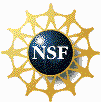 |
New Faculty Workshop
June 27 - 30, 2011
"Just-In-Time Teaching (JiTT)"
Andy Gavrin,
IUPUI

|
 |
Introduction
Many of us have long sought after ways to better tailor our
classes to our particular students' needs. We strive both to
provide timely remediation and drill to the weaker students and
to provide relevant enrichment material to the stronger
students. While totally individualized instruction is beyond
our reach, interactive use of the World Wide Web provides a
tool that approximates the ideal goal. In this session, we
explored the World Wide Web as a tool to improve and
individualize the learning experience by just-in-time sampling
of the students' status in the course and adjusting the
classroom activity accordingly.
In Preparation For The Session
You probably visited the "WarmUp" page. In the spirit of Just-in-Time
Teaching, the WarmUp page requested some input from you.
Some responses to questions raised in the Coments field, in case we do not get to everything during the session.
Session Presentation (avalable after the session)
"How to Get Your Students to Prepare for
Every Class"
Sources of free warmup (and other) questions
Building your own warmups
Additional JiTT Resources and References (other than
your JiTT book, which you have, thanks to Pearson
Education)
Implementations of JiTT
A Few Papers about JiTT:
- Just-in-Time Teaching: Active Learner Pedagogy
with WWW (1998)
- "What is Physics Good For?" Motivating Students
with Online Materials (1999)
- The Best of Both Worlds: WWW Enhanced In-Class
Instruction (2000)
- Marrs K.A. (2003), R. Blake, and A. Gavrin "Use of Warm Up Exercises in Just in Time
Teaching: Determining Students' Prior Knowledge and
Misconceptions in Biology, Chemistry, and Physics."
Journal of College Science Teaching, September 2003, pp.
42-47.
- Gavrin A., (2003) J. X. Watt, K. A. Marrs, and R. E.
Blake, "Just-in-Time Teaching (JiTT): Using the Web to Enhance
Classroom Learning." Computers in Education Journal, Vol.
XIV (2), in press.
- Using
On-Line Quizzes Outside the Classroom to Increase Student
Engagement Inside the Classroom (2003)
- Dissemination of JiTT (2006)
Relevant Pedagogy/Student Learning References
(non-JiTT-specific)
(Websites will open in a new window)
-
Alexander W. Astin, "What Matters in College? Four Critical
Years Revisited," Jossey-Bass Publishers, San Francisco,
1993.
- Top 3 critical factors
predicting college success:
- student-student interaction
- student-faculty interaction
- time on task (students learn what students
study)
-
Richard Felder's Learning Styles References:
-
Jim Benedict's Cognition and Knowledge Taxonomy Table:
Reference: Anderson, L.W., Krathwohl, D.R., Airasian,
P.W., Cruikshank, K.A., Mayer, R.E., Pintrich, P.R.,
Raths, J. & Wittrock, M.C. (2001).
A Taxonomy for
Learning, Teaching, and Assessing: A Revision of
Bloom’s Taxonomy of Educational Objectives. New
York: Longman.
-
Arnold Arons, "Some Thoughts on Reasoning Capacities
Implicitly Expected of College Students," Cognitive
Process Instruction: Research on Teaching Thinking
Skills, Jack Lochead and John Clement, Eds.
Philadelphia: The Franklin Press, 1979.
-
Wiggins, G. (1989). “Teaching to the authentic
test,” Educational leadership, 7, 41
– 47.
-
McClymer, J. F., & Knoles, L. Z. (1992). “Ersatz
learning, Inauthentic testing,” Journal on
Excellence in College Teaching, 3: 33 –
50.
-
Perkins, D. N. (1986). “Thinking Frames: An
Integrative Perspective on Teaching Cognitive
Skills.” In J. B. Baron & R. J. Sternberg, (Eds.)
Teaching thinking skills. New York: W. H. Freedman,
41 – 61.
-
Schoenfeld, A. H. (1979). “Explicit heuristic
training as a variable in problem solving
performance,” Journal for Research in Mathematics
Education, 10: 173 – 187.
-
Mazur, E. (1997). Peer Instruction: A User’s
Manual. Upper Saddle River, NJ: Prentice Hall.
Links to other relevant sites and references mentioned
(maybe!) during the Session (non-JiTT-specific)
Web sites mentioned/shown (will open in a new window):
Acknowledgments
Special thanks to Gregor Novak, of USAFA and IUPUI, and Evelyn
Patterson (USAFA) The "Just-in-Time Teaching" project has its
roots in a close collaborative effort among us and, several
faculty (former and current) at the US Air Force Academy
(including especially Tom Summers and Rolf Enger), and Wolfgang
Christian and Mario Belloni at Davidson College. Partial
support of this work has been provided by NSF grants
DUE-9752365, DUE-9981111, DUE-0333646.
Additional comments about JiTT
A few comments about the Just-in-Time Teaching with the World
Wide Web technique described at the New Faculty Workshop and on
these pages:
First, it is important to note that these activities are
based on results from physics education research. The web
outside-of-class (homework) component is followed up by a
strong and central in-class component in which the instructor
and the students address the ideas and explanations offered by
the students via the web assignment.
To understand this technique, it is crucial to realize that
the in-class activities start where the students are and
address what the students think, rather than assuming the
students know nothing about the topic at hand. In this way, we
are trying to more closely match "what we teach" and "what the
students learn." (Much of current Physics Education research
specifically addresses this issue. See, for example, Lillian
McDermott's American Journal of Physics article,
"Millikan Lecture 1990: What we teach and what is learned --
Closing the Gap," Vol. 59, 1991, p. 301, and also her
Ann. New York Acad. Sci. article, "How We Teach and How
Students Learn," Vol. 701, 9, 1993.) Our in-class
activities employ active learner and cooperative group problem
solving techniques (a la Patricia Heller's American Journal
of Physics articles, Vol. 60, Number 7, July 1992, pp.
627-636 and pp. 637-644). Thus our use of the web is founded
upon and employs established techniques in addition to
incorporating a new component.
In both the USAFA and IUPUI settings, where Just-in-Time
Teaching first began, specific issues must be addressed if we
hope to enhance our students' learning, and this just-in-time
technique provides an unprecedented opportunity to do so. For
both the IUPUI and USAFA students, time management is an
absolutely critical issue. The IUPUI students generally have
full time jobs, family responsibilities, and are taking courses
on top of already full schedules. The Air Force Academy cadets
are expected to uphold demanding academic, military, and
athletic responsibilities and find their 6 or 7 courses per
semester very challenging. As their instructors, we must help
them make the best possible use of their outside-of-class (and
in-class!) time, motivate them to spend the necessary time, and
help them to see that others are sharing their situation and
that they are not alone in their efforts to complete the
courses successfully.
The key specific goals of our courses are to:
- Encourage frequent, short study sessions
- Connect textbook physics to the real world
-
Encourage the development of
- critical thinking
- estimation skills
- the ability to deal with ill-defined problems
- Develop cooperative work habits and communication
skills
For much more information, browse through your copy of the
Just-in-Time Teaching book published by Prentice
Hall. Feel free to request more copies for colleagues!
Please, if you decide to adopt or adapt JiTT in your
course(s), and/or if you have any questions, let me know. I'll
be happy to help you if I can.
Andy Gavrin, IUPUI



